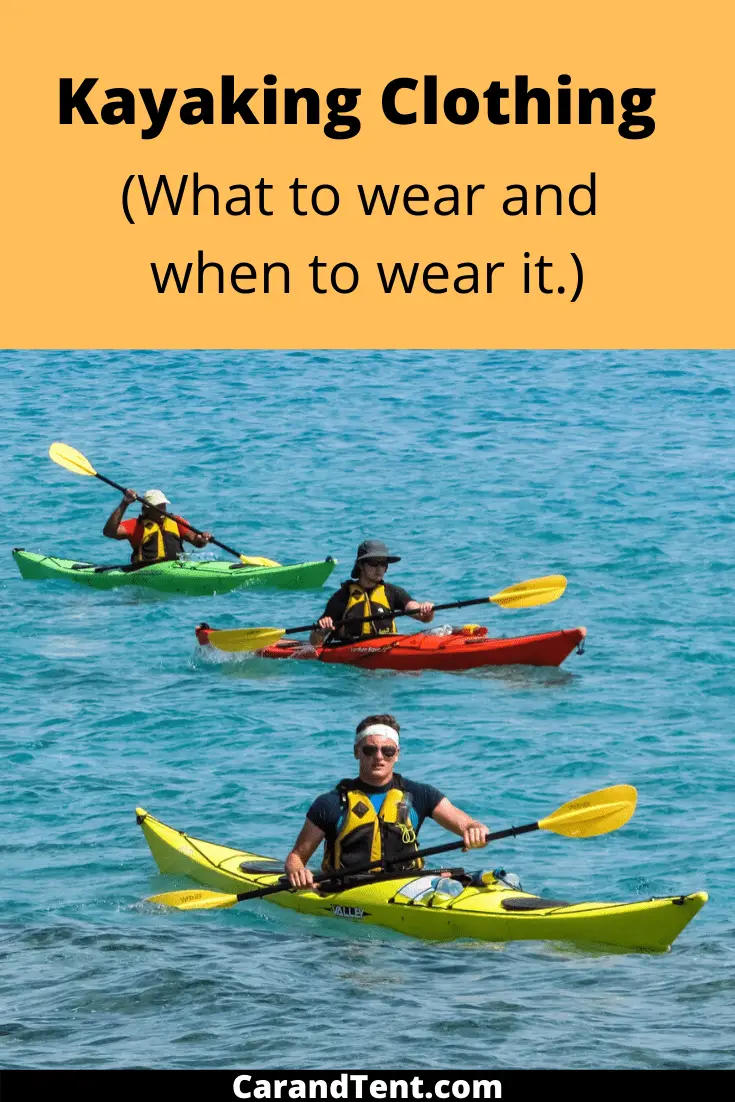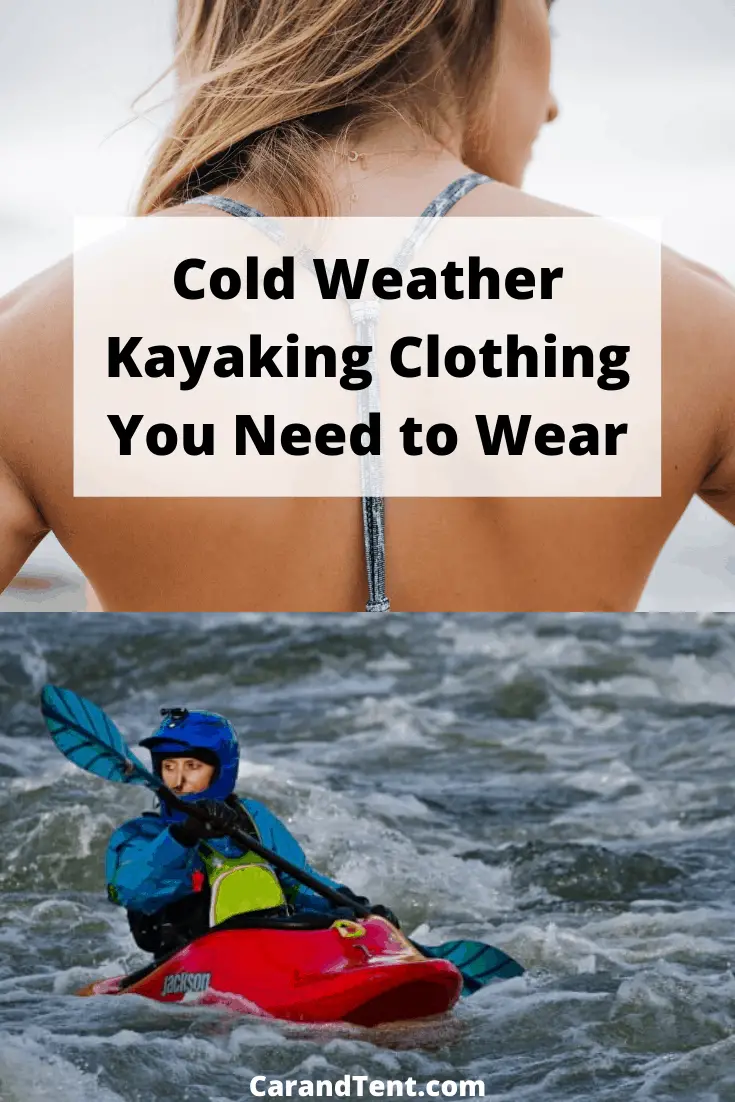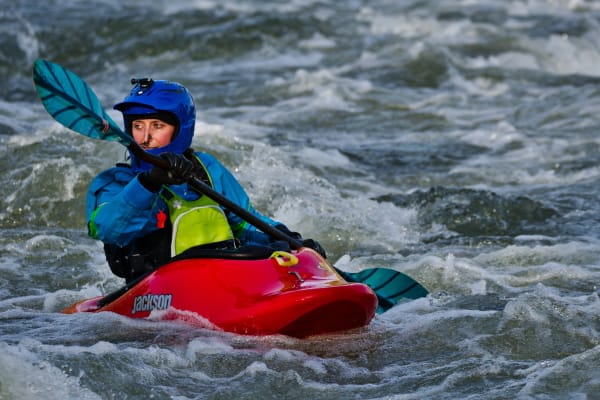
The clothing you wear when kayaking does more than just help you look like a kayaker. Your kayaking clothing will help keep you both safe and comfortable while you’re out on your kayak.
Wondering what to wear kayaking? In the warmer months, you’ll want to wear lightweight, quick-drying clothing that protects you from the sun. In the winter, you’ll want to wear multiple layers of quick-drying clothing that will protect you from the cold.
Basically, the clothing you wear needs to match the weather while meeting the additional need of being able to dry quickly. Warm-weather kayaking clothing is a lot less demanding than cold-weather clothing, but both types of trips require some forethought.
Table of Contents
Warm-weather Kayaking Clothing
In the warmer months of the year, your primary goal is to protect yourself from the sun. For shorter trips, this could simply mean throwing on a bathing suit, a hat, and a lot of sunscreen.
Longer trips might involve a wide-brimmed hat, long pants, and a loose-fitting long-sleeve shirt.
Kayaking Pants for Warm Weather
My preference is to wear a pair of lightweight hiking cargo pants with legs that zip off at the knees. These pants are usually made from a combination of nylon and polyester which is quick to dry and extremely lightweight.
The cargo pockets are an added bonus as I can store extra emergency gear in them without having to worry about losing it in the event that I capsize. I’ve found the pockets are the perfect size for small first aid kits, ponchos, and emergency blankets. They can also be good for holding a waterproof phone or camera.
Kayaking Shirts for Warm Weather
There are a few ways you can go in warm weather. Some people just lather up the sunscreen and leave a t-shirt in the bulkhead storage of their kayak.
Another option is to wear a t-shirt that will dry quickly. Under-armour or something similar works well for this but essentially most shirts made from synthetic materials like nylon and polyester will work.
I’m partial to wearing long sleeve shirts with collars on them. While that might sound like it might be too hot, it actually helps keep me warmer.
My go-to shirt is a button-down shirt made mostly from polyester with some nylon. It provides my entire upper body with protection against the sun and I unbutton the sleeves to get some additional airflow. As an added plus, (I think), my friends tell me I look like a professional outdoor guide.
Kayaking Footwear for Warm Weather
If you’ve read my post on barefoot kayaking, you know that I don’t recommend it anywhere but the beach. You never know what kind of area you may have to walk through during a kayaking trip so it’s better to be prepared with adequate footwear than to go home with injured feet.
In the summer I prefer to wear a good pair of hiking sandals but some people prefer water shoes instead. Both will dry quickly and both will give you good traction on wet rocks. As an added bonus, you can clean either one of these after the trip by spraying them out with your garden hose. Whichever one of these kayaking shoes you choose, you really can’t go wrong.
Kayaking Hats for Warm Weather
I don’t bother with a kayaking hat when I’m kayaking in the ocean. Typically I’ll end up riding waves in and out and with the number of times I capsize a hat wouldn’t last the trip.
When I’m kayaking on a river or on a lake, I always wear a hat. The sun can get brutal out on the water and a hat helps keep me cool.
My advice is to choose a hat that is unlikely to be taken by the wind. A ballcap will work and will provide your head and face with protection from the sun but a Boonie hat is better since it’ll protect your neck as well.
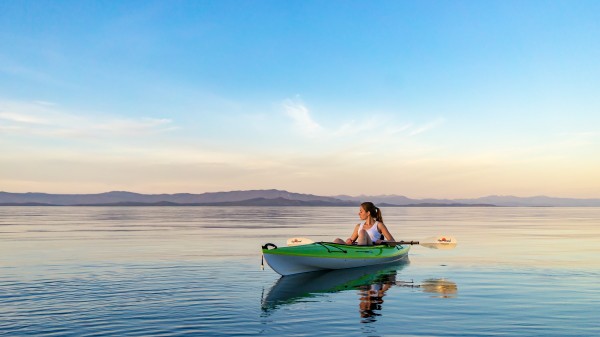
Cold-weather Kayaking Clothing
Dressing poorly on a warm-weather kayak might result in an uncomfortable trip, or at worst, a bad sunburn. Dressing poorly for a cold-weather kayaking trip, on the other hand, can lead to much more serious issues.
The wrong choice of footwear can lead to frostbite and the wrong choice of clothing could lead to hypothermia or even death from exposure. For these reasons, it’s especially important that you carefully plan out what you’ll wear when kayaking in the cold.
Kayaking Tops for Cold Weather
Whenever you’re kayaking in cold weather, you’ll want to dress in layers. Your base layer should be one that can wick moisture away from your body. This will help in case you end up working up a sweat while your paddling.
The next layer might be a thicker layer to help keep you warm. This layer should also be one that will not hold water. Stay away from cotton and even wool if possible. Instead, go with a synthetic material like neoprene, polypropylene, gore-tex, or even fleece. These materials will help you keep warm and they’ll shed water much quicker than wool or cotton.
On top of all of this, you’ll want a waterproof layer. A waterproof jacket made from nylon will help to work as a windbreaker while keeping you warm at the same time.
Kayaking Pants for Cold Weather
When you’re on a kayak, you’re likely to end up sitting in a puddle of water. You can reduce the chances of this happening by getting a sit-in kayak with a skirt but even then, you may still end up getting some water inside. As a result, you’ll once again need to dress in layers.
Wear a base layer that will keep you warm and wick moisture away from your body. A good pair of polypropylene pants work well for this. Over top of this, you’ll want to wear a pair of waterproof pants. Typically, these will be made from nylon as well.
Kayaking Footwear for Cold Weather
The same water shoes you wore in the summer can be used in the winter as well. However, you’ll want to add a pair of neoprene booties to this to help keep your feet warm. If you don’t have neoprene booties, a good pair of wool socks can help as well.
One word of caution is to leave your boots at home. Even a nice pair of gore-tex boots will be less than ideal on a kayaking trip. These boots will capture water, they won’t dry out quickly enough, and they’ll be very heavy if you end up having to swim in them.
Additional Options
Two other cold-weather options are the wetsuit and the drysuit. The names of these two suits neatly sum up the benefit of using each but let’s take a look at them in more detail below.
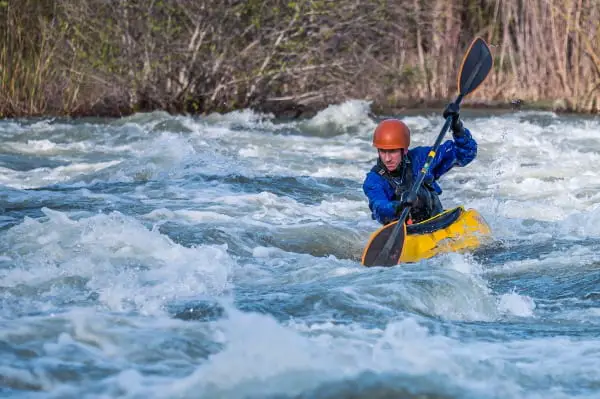
Kayaking Wetsuits
The main advantage of a wetsuit is that it doesn’t matter if you get wet. A wetsuit is made from neoprene insulation. This material helps to trap water near your body in such a way that it can be warmed through your body heat. This water then stays trapped next to your body to help keep you warm.
An additional advantage of the wetsuit is that it’s skin tight. This allows for easier movement as you’re body isn’t constricted with multiple layers of bulky clothing.
One problem with the wetsuit is that an ill-fitting wetsuit can end up letting too much water next to your body. This can result in you being colder which can be dangerous so it’s important to try on your wetsuit at least a few days before your trip. This will give you the time you need to get a new one if you have to.
Another issue with wetsuits is that they can easily cost several hundred dollars. This can be a lot of money for someone who might only do one or two cold-weather kayaking trips a year. However, if you plan on using it a lot or for other purposes like surfing or stand-up paddleboarding, it might easily be worth it.
Alternatively, you could rent a wetsuit for kayaking each year. This will save you money and ensure that you always have a wetsuit that fits you properly.
Kayaking Drysuits
A drysuit does the exact opposite of a wetsuit. Drysuits help to keep you completely dry even if you end up capsizing.
These suits can be made with a neoprene outer or a membrane shell. The neoprene outer will provide an additional layer of warmth while keeping you dry while the membrane will only keep you dry. The benefit to the neoprene suit is that you may not have to wear any additional layers and the benefit to the membrane suit is that you can control your level of warmth by adding or subtracting interior layers as necessary.
In addition to a dry suit’s shell, it also has gaskets around the hands and the neck. A latex gasket will keep you completely dry while a neoprene gasket may let some water in during rolls or capsizes.
If you’re going to be in rough water or really cold temperatures, a latex gasket is the way to go. Otherwise, you may want to go with the neoprene gasket as it’s more comfortable to wear.
Drysuits can be entered from the front or from the back. Drysuits that are entered into from the back often require a second person to zip them up.
The major drawback to the drysuit is that it’s expensive. A good drysuit will cost you over a thousand dollars. Also, the drysuit gaskets can become damaged over time so it’s important that you periodically inspect them or you’ll end up with a semi-dry suit that doesn’t keep you completely dry anymore.
Safety Gear
On top of your clothing, you’ll also want to wear a life vest. Get one that is built for kayaking so that you’ll have the freedom of movement you need to paddle. The brighter the color of the life vest, the better as this will help rescuers find you in an emergency.
Also, some conditions may require the use of a helmet as well. If you’re a beginner kayaker, I’d stay away from these areas for now. You can always tackle the heavier rapids after you’ve gotten more experience.
TL;DR
Think carefully before picking out clothing to wear on your next kayaking trip. Pick the wrong clothing and the best-case scenario is that you’ll be uncomfortable and the worst-case scenario will be that you don’t survive the trip.

